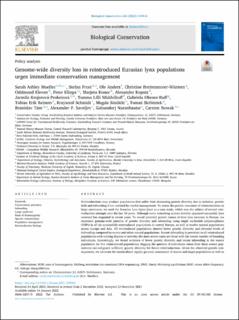Genome-wide diversity loss in reintroduced Eurasian lynx populations urges immediate conservation management
Mueller, Sarah Ashley; Prost, Stefan; Anders, Ole; Breitenmoser-Würsten, Christine; Kleven, Oddmund; Klinga, Peter; Konec, Marjeta; Kopatz, Alexander; Krojerova-Prokesova, Jarmila; Middelhoff, Tomma Lilli; Obexer-Ruff, Gabriela; Reiners, Tobias Erik; Schmidt, Krzysztof; Sindicic, Magda; Skrbinsek, Tomaz; Tám, Branislav; Saveljev, Alexander P.; Naranbaatar, Galsandorj; Nowak, Carsten
Peer reviewed, Journal article
Published version

Åpne
Permanent lenke
https://hdl.handle.net/11250/3010353Utgivelsesdato
2022Metadata
Vis full innførselSamlinger
- Publikasjoner fra CRIStin - NINA [2397]
- Scientific publications [1423]
Originalversjon
10.1016/j.biocon.2021.109442Sammendrag
Reintroductions may produce populations that suffer from decreasing genetic diversity due to isolation, genetic drift and inbreeding if not assisted by careful management. To assess the genetic outcomes of reintroductions in large carnivores, we used the Eurasian lynx (Lynx lynx) as a case study, which was the subject of several reintroduction attempts over the last 50 years. Although some restocking actions initially appeared successful, lynx recovery has stagnated in recent years. To reveal potential genetic causes of slow lynx recovery in Europe, we examined genome-wide patterns of genetic diversity and inbreeding using single nucleotide polymorphisms (SNPs) in all six successfully reintroduced populations in central Europe, as well as twelve natural populations across Europe and Asia. All reintroduced populations showed lower genetic diversity and elevated levels of inbreeding compared to source and other natural populations. Recent inbreeding is prevalent in all reintroduced populations with varying degrees of severity; the most severe cases are those with the lowest number of founding individuals. Interestingly, we found evidence of lower genetic diversity and recent inbreeding in the source population for five reintroduced populations, begging the question if individuals taken from these source populations can safeguard sufficient genetic diversity for future reintroductions. Given the observed genetic consequences, we advocate for standardized regular genomic assessment of source and target populations as well as individuals prior to release. Our study provides compelling evidence for the serious consequences of founder population size on the genetic diversity of reintroduced large carnivore populations, which has broad implications for their conservation. Conservation genomics Inbreeding Large carnivore Runs of homozygosity Species translocation Population management Reintroduction biology
